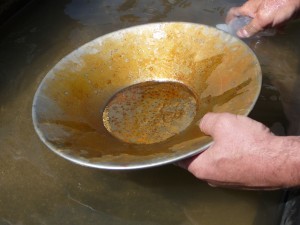“You’re in wetsuits moving rocks underwater by hand and vacuuming up the sand and gravels in between… and hopefully some gold,” says Dunn. The heavier material is collected in a sluice box, while the lighter material is released back into the water.
With gold prices topping $1,500 an ounce, a weekend trip can be lucrative.
“My typical take would three quarters of an ounce to an ounce. And this is significant enough income to change most people’s lives for the better,” says Dunn.
But for almost two years, using this equipment has been banned while the state considers the environmental impact on salmon and other fish.
“When the dredgers are going in, they’re stirring up a lot of fine sediment and that may be moving downstream. And the issue there is, when the water is muddy, fish that need to feed visually can’t see their food,” says U.C. Davis biologist Lisa Thompson.
Others are concerned that the suctioning also picks up mercury, adding it back into the river. Scientists say the dredging equipment can actually capture some mercury, smaller particles are re-suspended in the water and travel downstream.
The California Department of Fish and Game has proposed rules to limit when and where the mining can be done. The agency’s Mark Stopher says the limits were written to avoid fish spawning season and rivers with threatened species.
The proposed rules also cap the number of dredging permits at 4,000 and limit the size of the dredging equipment. Public comments can be submitted through May 10.

